Key Takeaways
- Average number of token holders grew 31% QoQ, though total new wallet interactions were down.
- Average number of daily transfers and total transfer volume fell, as the bear market chilled trading activity across the crypto industry.
- Market valuation rebounded at the end of Q3 relative to the prior quarter.
- ApeCoin DAO passed several common-sense proposals as well as some big bets on brand and marketplace initiatives.
- Development on The Otherside metaverse progressed, with the first public tech demo held successfully in mid-July.
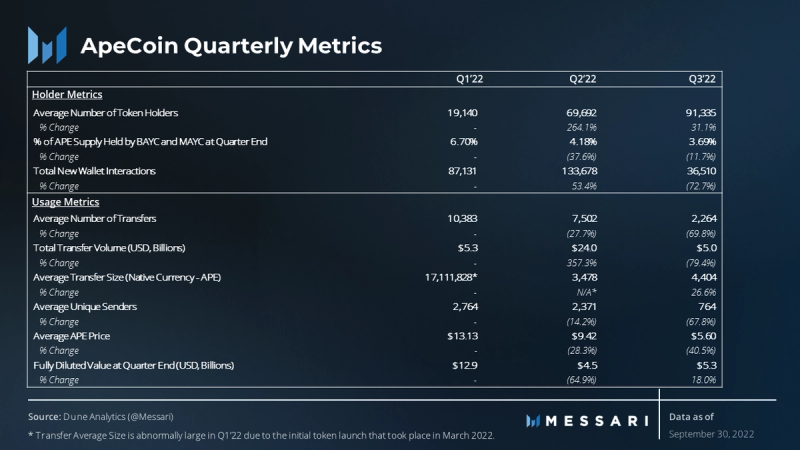
Primer on ApeCoin
APE is the native token of the APE Foundation, a legal entity that administers the decisions of the ApeCoin DAO. While ApeCoin is often conflated with Yuga Labs, the creators of the Board Ape Yacht Club (BAYC), the two are separate entities.
Since launch, BAYC and MAYC (Mutant Ape Yacht Club) holders have been the largest voting cohort among ApeCoin DAO members due to their initial airdrop claim eligibility. In addition to the 15% allocation for BAYC / MAYC NFT holders, a ~16% share of token supply was allocated to Yuga Labs itself (6.25% of this allocation marked for donation to the Jane Goodall Legacy Foundation, amounting to 1% of the token supply), with another 8% of the supply divided among the four Yuga Labs founders. At least 39% of APE’s total supply can be closely linked to BAYC stakeholders, creating an inherently tight alignment of incentives between the BAYC community and ApeCoin DAO. Nearly 70% of the token supply remains locked.
The ApeCoin DAO is expected to further decentralize over time as tokens flow through the ecosystem across a more diverse group of holders and communities. The underlying priorities of the ApeCoin DAO should gradually reflect its member base, as an increasing number of novel pathways form, promoting the exchange of APE (metaverses, shops, experiences, etc).
One of the first projects to integrate ApeCoin as the native currency will be The Otherside metaverse in development by Yuga Labs.
Quantitative Analysis
FDV and Price
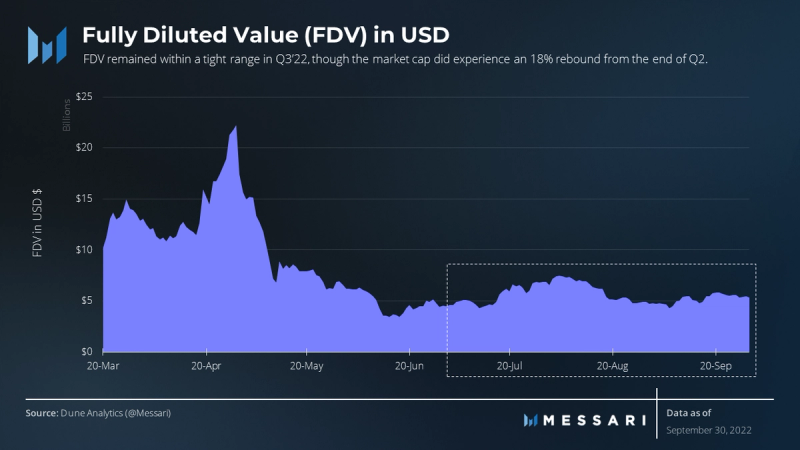
ApeCoin launched on March 17, 2022, with a starting token price near ~$10 and a fully diluted market cap of ~$10 billion. The token price gradually rose throughout April in anticipation of The Otherside land minting event on April 30, 2022, with the fully diluted value reaching as high as ~$22 billion. After the completion of The Otherside mint, much of the memetic momentum dissipated, and the price action ultimately followed the broader market sell-off.
The fully-diluted value of ApeCoin reached a low of $3.5 billion in mid-June before rebounding in Q3 due, at least in part, to ApeCoin’s integration with BitPay, which delivers ApeCoin holders access to Gucci purchases.
APE Supply Held by BAYC & MAYC Owners
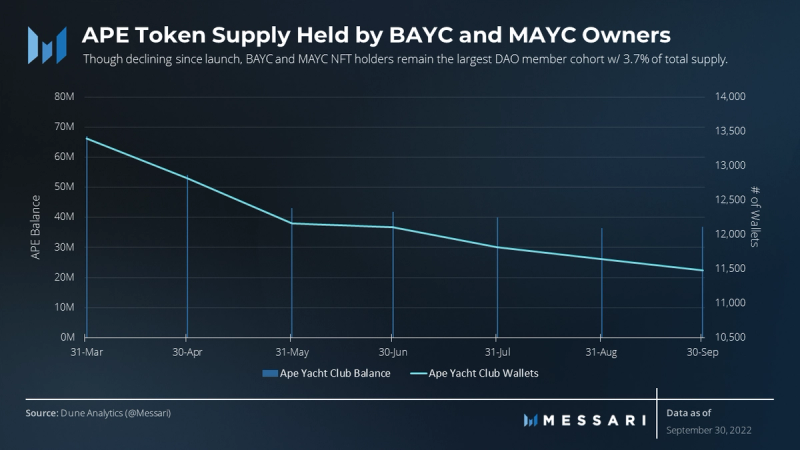
15% of the 1 billion APE was allocated to BAYC and MAYC holders. By the end of Q1, the share of BAYC and MAYC APE balances sat at 6.7% of total APE supply (~21.3% of the circulating supply) spread across ~13,400 wallets.
This share continued to decline through Q2 and Q3 as these holders gradually sold and/or transferred their APE stashes, with a 1,914 net decline in wallets. By the end of Q3, the BAYC and MAYC ApeCoin balances were 3.7% of the total APE supply (11.7% of the circulating supply) and this supply was divided across 11,485 wallets or 12.6% of the total holder count.
Holder Count by Size

As of the end of Q3, 96,250 unique wallets collectively hold ApeCoin’s total supply, distributed as:
- Krill (1,000 APE or Less): 61,607 wallets / 63.9% of holders
- Fish (1,000 – 10,000 APE): 22,259 wallets / 23.1% of holders
- Seal (10,000 – 50,000 APE): 7,595 wallets / 7.9% of holders
- Dolphin (50,000 – 100,000 APE): 2,356 wallets / 2.5% of holders
- Shark (100,000 – 1 million APE): 2,131 wallets / 2.2% of holders
- Whale (1 million APE or More): 400 wallets / 0.4% of holders
Only Krill holders experienced a QoQ increase, growing their share by 4.2% of total holder count. However, the Fish cohort experienced the largest share decline, down 2.3%, which is expected as APE supply decentralizes over time.
Holding Time – % of Supply
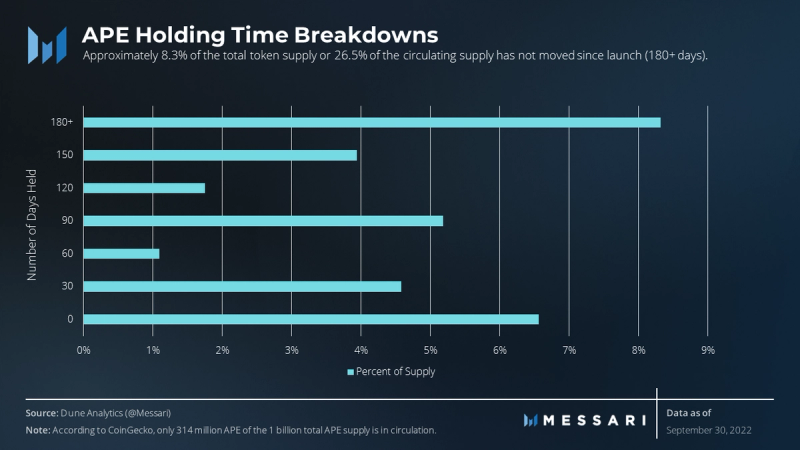
Analyzing holding time patterns can offer a deeper understanding of the underlying holder base, providing context of token use. After accounting for the 68.5% of token supply remaining locked and uncirculated, 8.3% of the total token supply (26.5% of the circulating supply) has remained stagnant since March 17 at 180-plus days held — the largest grouping of liquid supply. The second largest supply cohort of tokens are those held up to 30 days (20.9% of the circulating supply).
Given the token’s relatively young circulation life, these two main groupings come as no surprise. Both of these cohorts align with common investing patterns in crypto: “HODLers” and “Speculators.” When HODLers acquire tokens, they will choose to hold on to at least some portion no matter the price action. Since much of ApeCoin’s current circulating supply was made available through an airdrop at effectively a zero-cost basis, those recipients have little financial risk if they choose not to sell (other than the opportunity cost of not selling at a higher price). More recent holders could be considered speculative investors taking advantage of the near-term volatility in token prices, driven by broader market turmoil.
New APE Holders
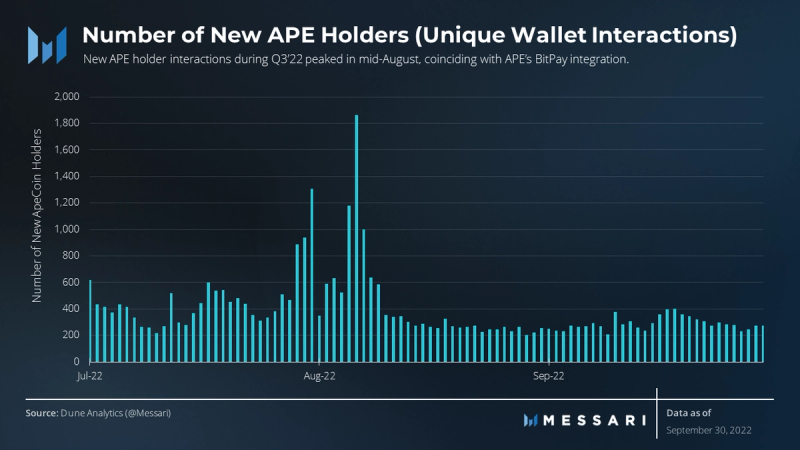
On average, roughly 250 new holders were added per day, with the exception of higher growth numbers briefly coming off the BitPay integration in early August. New user interactions, defined as instances where APE was added to a new wallet, shrunk by 72% after posting 53% growth in Q2.
The DAO will look to proposed product initiatives such as developing a nocode NFT drop platform fueled by the APE token to catalyze future holder growth. Additionally, the development of the Otherside metaverse continues to be a large potential catalyst on the horizon.
APE Token Transfers
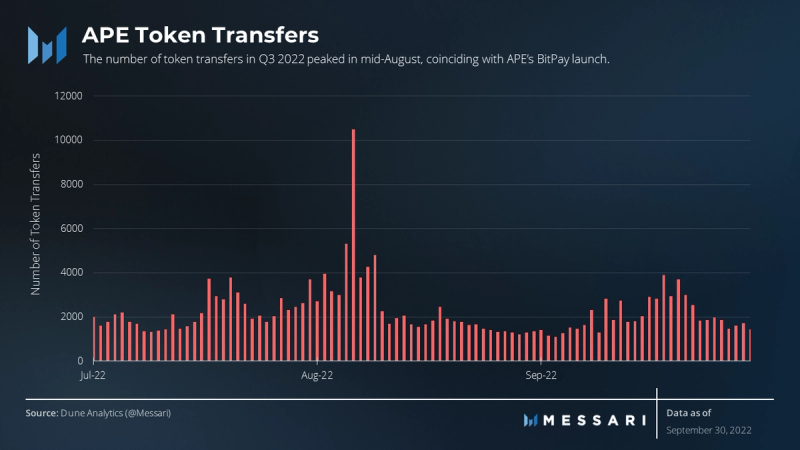
Total token transfers showed a similar spike off the BitPay integration in August. While the average transfer size denominated in APE increased 27% in Q3, the total number of transactions and total USD value of those transactions decreased by 70% and 80%, respectively.
Volume Share by User Size
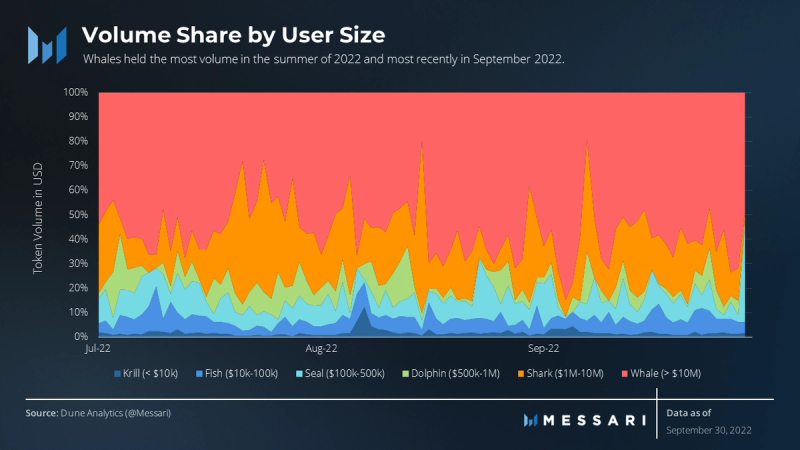
Whales (> $10 million) dominated APE trading volume for most of Q3. Beyond them, Seals ($100,000-500,000 ) grew their share of volume the most by Q3’s end, almost entirely replacing the larger Dolphins ($0.5-1 million-1M) and Sharks ($1-10 million) by volume. As more products like the NFT marketplace and the OtherSide game launch, expect smaller holders to gain volume share in anticipation.
Qualitative Analysis
Governance Updates – Ape Improvement Proposals (AIPs)
APE token holders are entirely responsible for the maintenance of the ApeCoin DAO’s governing rules. Governance participants can vote on community-led proposals such as grant distributions from the DAO treasury, the APE staking program, internal DAO operations, Board Elections, partnerships, and more. These proposals are labeled under three main categories: Process, Ecosystem Fund Allocation, and Brand Decision.
The following is a series of approved governance decisions with high protocol impact that passed during the prior quarter:
AIP-64: APE Coin Festival – Bringing NFT Communities Together – Brand Decision
This proposal received approval for a Feasibility Study to secure letters of interest from various NFT communities, brands, sponsors, venues, and event companies in an effort to collaborate on a DAO-owned and managed conference/festival (“Web3 Village”). Once interest has been established, a separate proposal will be submitted that will detail the logistics of the event.
The idea for this event was inspired by the popular NFT-NYC event, given its success in bridging multiple online communities. By combining the resources of key partners and communities, ApeCoin DAO could establish an event that achieves similar success while also elevating the ApeCoin brand as a founding member of this Web3 Village.
AIP-70: Bored Ape Gazette: ApeCoin Media/BAYC News – Ecosystem Fund Allocation
With the passage of this proposal, The Bored Ape Gazette was approved for grant funding that will be used to expand its operations and scope through continuous research, analysis, and reporting across the ApeCoin and Bored Ape ecosystems.
The Bored Ape Gazette has been operating since June 2021, becoming a trusted source of information for the Bored Ape community. Through this funding, this Bored Ape-centric news organization will be further aligned with the ApeCoin DAO, building a mutually beneficial relationship between the two organizations as they grow.
AIP-88: Earn ApeCoin Revenue Through Our No-Code NFT Drop Platform & Launchpad – Ecosystem Fund Allocation
This proposal provides NiftyKit, a No-Code NFT Launchpad, with the funding necessary to integrate APE as a new form of payment on its platform. NFT creators using NiftyKit will be able to accept APE as payment during minting events. Through this integration, the ApeCoin DAO hopes to see new ApeCoin holders join the ecosystem as creators without prior APE experience begin to earn APE as payment for their NFTs.
Additionally, this close alliance with a budding NFT launchpad could prove useful to the ApeCoin community during ApeCoin-related NFT launch events. In total, this partnership with NiftyKit is an example of new forms of utility that may help boost ApeCoin’s “velocity of exchange.”
AIP-89: Improved delegation experience – Process
This AIP improves the delegation experience by adding an application process and allowing users to easily delegate and re-delegate directly from the ApeCoin site.
AIP-91: Ape&Talent – Platform to connect talent within the Ape community – Ecosystem Fund Allocation
This proposal provides funding for the creation of a new job board called Ape&Talent.
As described in the proposal, “This AIP proposes the creation of a platform that facilitates the connection of talent/needs between the Ape community: BAYC, MAYC, BAKC, and ApeCoin holders… In summary, it’s a marketplace (platform) where the Apes will be able to include their talents or what fields they have experience and believe they can help to the community but on the other side, instead of being businesses/agencies, they will be the Apes themselves.”
AIP-96: Funding for Public Goods (ETHGlobal & Gitcoin) – Ecosystem Fund Allocation
This proposal sets aside $200,000 in APE “to fund hackathons and grant programs for people building for ApeCoin. The funding will be distributed across three initiatives: Ethereum Foundation’s upcoming ETHOnline hackathon, a dedicated Gitcoin ApeCoin ecosystems grant program, and Gitcoin’s Change program.”
Through participation in these Web3-centric events, ApeCoin DAO hopes to garner more visibility for its brand and grow a foundation of developers for its ecosystem.
AIP-98: A Community-First ApeCoin DAO Marketplace Proposal – Brand Decision
This proposal provides the funding needed to develop ApeCoin DAO’s own secondary marketplace for NFTs. This marketplace will follow several key guidelines, as described in the proposal:
- Composability means parts of a system can be replaced and recombined so you can easily replace us as the ApeCoin DAO marketplace front end without impacting users.
- Non-extraction means not charging more than you need, we take just enough to cover operating costs and keep building so we can do our best to return value to creators.
- Interoperability means systems ability to use available data. By leveraging Reservoir0x we can both aggregate the most liquidity and make data available for aggregators and other user applications, something MagicEden has blocked on its Solana marketplace.
Through this APE-native marketplace catering to ApeCoin-related NFTs, such as BAYC and Otherside Otherdeeds, ApeCoin DAO hopes to drive adoption of APE (listings denominated in APE), drive traffic to the ApeCoin DAO site, and decrease fees to community members.
AIP-113: Extending AIP-1 – the DAO Process – Process
The terms of the Foundation’s relationship with the DAO, led by The Board, were established on a six-month basis in AIP-1. The Board’s initial six-month term would have ended on October 17. However, on September 22, the DAO voted to extend the term by an additional three months, providing time for the development of a formal process to administer Board nominations and elections. The APE Foundation will collect community input to be condensed into a congruent policy.
Closing Summary
Given its relatively ambiguous agenda and crypto-native member base participating in the DAO, ApeCoin can be considered one of the most pure-play bets on “Web3” meets “The Metaverse” currently available to market participants. As such, it’s inherently one of the more speculative and volatile tokens despite its considerable FDV. Q3 saw the ApeCoin DAO hard at work, voting on some common-sense proposals as well as several big bets. It’s clear there will be plenty more to come on that front, in the quarters and years to come. Holder count and price action throughout Q3 seemed to react positively to these developments, relative to where things stood at the end of June.
One exciting development still on the horizon is The Otherside integration – which will act as a “minimum-viable-product” to show the (digital) world just how well APE holds up as a native currency. If the economy within Yuga’s metaverse grows prosperous while using APE as the medium of exchange, other Web3 communities may grow convinced to adopt the token in some capacity as well. Of course, an increase in usage across more ecosystems would likely benefit the early adopters and holders of APE. Being that this “Web3 Roblox” is still deep in beta, holders will need to remain patient as they withstand the bear market riptide.
















